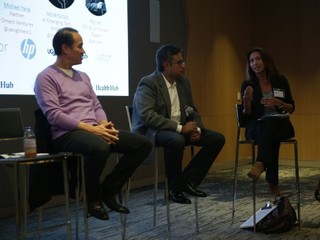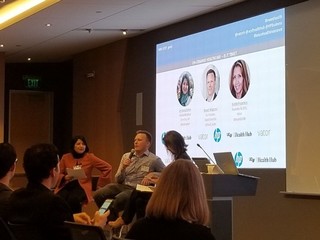Advancing toward a brain on a chip: addressing the need to find therapeutics that work
The webinar included representatives from ACRO Biosystems, Bristol Myers Squibb, and eNuvio
Read more...
(Editor's note: Invent Health can help startups make connections to strategics and investors in the following areas. If you want to present on stage and get insights into specific areas, we'd love to get to know you. We are looking for startups in the following areas: Mental and Behavioral Health [apply]; In-home devices [apply]; Wellness, Lifestyle as medicine [apply]; REGISTER for March 25, 2020: Future of Mental and Behavioral Health)
At The Future of Health Insurance, the latest healthcare salon held by Vator, UCSF Health Hub and HP, one of the panelists was Jonna Kurucz, head of AI and emerging tech at Anthem.
Of course, having the second largest health insurance company, in the United States, behind only UnitedHealthcare Group, with over 40 million members, we wanted to know: how is the company innovating and using emerging technology?
Kurucz was totally prepared for the question and so she rattled off all the ways Anthem is, in her words, going from being an insurance company to a tech company.
"If I look at the construct of the individuals that we’re hiring today, they really come from a consumer background and a ton of tech and digital people. We have hired a number of really smart people from companies in Silicon Valley that are really leading us to be what we call a ‘digital-first organization.’ That’s really leveraging technology and starting with the base stack, and then looking at the different constituents that we interact with on a regular basis, whether it’s brokers and consultants, whether it’s providers, whether it’s members, whether it’s employers, and completely transforming the way that we interact with those individuals," she said.
She also pointed out all the ways Anthem is now using things like analytics, as well as artificial intelligence and machine learning, across the company, changing the way patients interact with their member portal, as well as the way customer service interacts with members.
"It starts with our analytics, which power our providers, our service advocates, our clinicians that are working with members, and it also powers our digital platform," she said.
"Historically, we leveraged retrospective data. So, think about a claim that occurred in the past, an HRA that was filled out in the past or a biometric screening that was done, could be even close to a year ago. What we started to do about three years ago was layer in social determinants, very, very, meaningfully, to determine whether someone could be expected to have a certain clinical condition, based on the specific zip code."
One the company also layered in machine learning and AI along as well, that's when it started to see "some astounding results," including being able to identify potentially at-risk individuals more than 150 days sooner than they had been before. That allows the company to intervene earlier and allows them to save money by directing them to a high quality, but lower cost, facility.
"Also what we learned is we were getting at individuals who were becoming emerging risks, versus those who were at-risk. Again, you have the opportunity to modify behavior if it’s an emerging risk," said Kurucz.
The company's AI and machine learning can also be leveraged in numerous ways, including making interactions with customer service better for both sides. For example, if someone is on the phone with someone from Anthem, they mostly want to know what their covered benefits are; Anthem uses an associate assist AI to automatically bring up the relevant information for the customer service representative, automatically populating the screen with the patient's deductible and their coinsurance. It can also anticipate that the member's next question, which might be, for example, "How much have I already paid towards my deductible and coinsurance?"
"This allows for a much better service advocate experience, because the data is right there, and it’s a much better member experience because they’re not having to put the member on hold to go to the screen to look up the deductible and coinsurance," Kurucz said.
Artificial intelligence and machine learning can be used to help the member try to find a primacy physician, as well as on the digital platform, allowing Anthem to push the most appropriate content to that individual that is most likely to get them to engage.
"Based on how that individual continues to interact with the system, we’re learning that if we push a message this way they’re not going to answer it, but if we push it that way then they’re going to answer it," she said.
On the member-facing side, the company has introduced a chatbot to automatically answer member questions, as well as what Anthem calls a "symptom triage tracker," where patients can fill out a decision tree of questions, which the AI and machine learning will use to find them the appropriate site of care and then help direct them there.
"So, you can see that all through the member journey, we are deploying technology to make it much more efficient, a much better member experience. We don’t think of ourselves as an insurance company, we’re really a digital-first entity," said Kurucz.
Michael Yang, Partner at OMERS Ventures, responded by going back to what Kurucz said originally about hiring more tech people at her insurance company, pointing out the irony that more tech companies are now hiring insurance people.
"Most of the founders that are going after health insurance, come from tech, they actually don’t come from health insurance, so they are learning on the job half the equation of what they’re competing in and that leads to a lot of waste of venture dollars as you’re funding their education," he said.
"It usually takes a couple of years before they actually start to hire a bunch of health insurance people into their business. So, you’re hiring tech people into your business, they’re doing the opposite, and it’s just kind of like swap of talent between the two industries."
Thanks to our sponsors Avison Young, Scrubbed, Stratpoint, UCSF Health Hub and HP.
The webinar included representatives from ACRO Biosystems, Bristol Myers Squibb, and eNuvio
Read more...At Invent Health, healthcare execs and investors discuss why infertility rates are so high
Read more...The panel included Genoscience, Emmeline Ventures, Suncoast Ventures, Wisp, and GENESIS Fertility
Read more...
Joined Vator on

